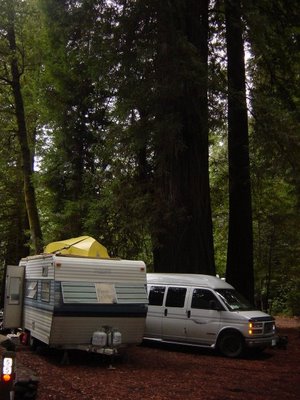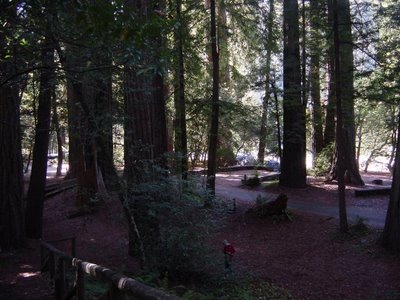The secret life of redwoods

This was our campsite at the Jedediah Smith State Park. The campground was beautiful, along a river, and full of redwood energy. It was amazing to the kids and I to find out that, first of all the redwood pine cones are tiny compared tot he trees, and that less than one in a million seeds will make it to maturity.

Here in the JSSP , we are camped among the redwoods. These majestic trees have borne witness to thousands of years and countless generations of humanity. Some of these trees are over two thousand years old, nearly half the age of their relatives, the giant sequoias. Call me a new age nutcase, but I swear you can feel the energy of these trees. Standing inside one of the hollow ones (sometimes the core will rot out, while the rest of the tree remains strong) you can feel the “energy” of the tree. I cannot explain it, but it is true nonetheless.
Each tree is a veritable city unto itself, teeming with wildlife, a squirrel skyscraper. Indeed, a felled one could build an entire (tiny) town with the lumber produced! Words Fail me to characterize the experience of walking through a redwood forest, so I would encourage each and every one of you who has not been here to make a pilgrimage to see these ancient giants.
Tamer and I had an amazing "Date Night", here in the midst of this amazing forest. We snuggled inside of a redwood (along with tons of EWWWWWWWW, spiders), and saw the brightest, biggest most beautiful full moon ever. We debated whether or not it really was a rare and amazing sight or if us Alaskans never have the opportunity to see such a majestic moon. At any rate, the campfire conversation was a welcome break from the chaos that we had been a part of!!



0 Comments:
Post a Comment
<< Home